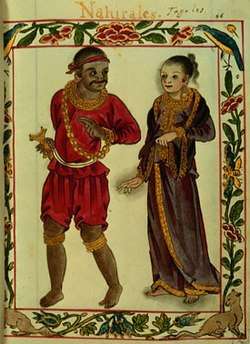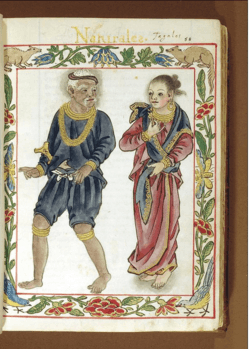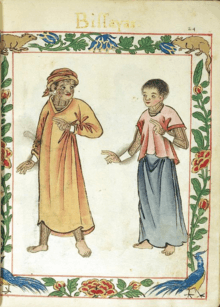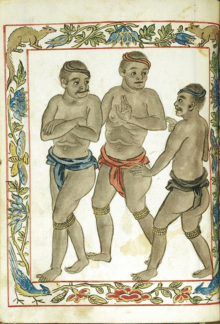Barangay state
| Pre-Colonial History of the Philippines |
 |
|---|
| Barangay government |
| Ten datus of Borneo |
| Legendary |
| Suwarnapumi |
| Chryse |
| Ophir |
| Tawalisi |
| Wāḳwāḳ |
| Sanfotsi |
| Zabang |
| States in Luzon |
| Caboloan (Pangasinan) |
| Ma-i |
| Rajahnate of Maynila |
| Namayan |
| Tondo |
| States in the Visayas |
| Kedatuan of Madja-as |
| Kedatuan of Dapitan |
| Rajahnate of Cebu |
| States in Mindanao |
| Rajahnate of Butuan |
| Sultanate of Sulu |
| Sultanate of Maguindanao |
| Sultanates of Lanao |
| Key figures |
| History of the Philippines |
| Portal: Philippines |
In early Philippine history, the barangay was a complex sociopolitical unit[1] which scholars have historically[2] considered the dominant organizational pattern among the various peoples of the Philippine archipelago.[3] [4]
These sociopolitical units were sometimes also referred to as barangay states[4], but are more properly referred to using the technical term "polity", rather than "state",[3][5] so they are usually simply called "barangays",[4][1] but evidence suggests a considerable degree of independence as a type of "city states" ruled by datus, rajahs and lakans and sultans[6]. Early chroniclers[7] record that the name evolved from the term balangay, which refers to a plank boat widely used by various cultures of the Philippine archipelago prior to the arrival of European colonizers.[1][3]
Some barangays were well-organized independent villages, consisting of thirty to a hundred households.[4][8] Other barangays - most notably those in Maynila, Tondo, Panay,[9] Pangasinan, Cebu, Bohol, Butuan, Cotabato, and Sulu[5][10] - were integrated into large cosmopolitan polities.[1]
Anthropologist F. Landa Jocano defines this period of the barangay states' dominance - approximately the 14th to the 16th centuries - as the "Barangic Phase" of early Philippine history.[4]
Historical barangays should not be confused with present-day Philippine barrios, which were officially renamed barangays by the Philippine Local Government Code of 1991 as a reference to historical barangays.
Description
Historically, the first barangays started as relatively small communities of around 30 to 100 families, with a population that varies from one hundred to five hundred persons. When the Spaniards came, they found communities with twenty to thirty people only. They also encountered large and prestigious principalities.
The coastal villages were more accessible to trade with foreigners. These were ideal places for economic activity to develop. Business with traders from other Countries also meant contact with other cultures and civilizations, such as those of Japan, Han Chinese, Indian people, and Arab people.[11]
In time, these coastal communities acquired more advanced cultures, with developed social structures (sovereign principalities), ruled by established royalties and nobilities.[12]
Smaller Barangay settlements
The smallest barangays were communities of around 30 to 100 households,[4] led by a Datu,[8] or a leader with an equivalent title. This was the typical size of inland settlements by the time the Spanish colonizers arrived in the late 1500s, whereas larger, more cosmopolitan polities dominated the coasts, particularly river deltas.[10][3]
Barangays as apex city states
When barangays grew larger, as was the case in Maynila, Tondo, the Madja-as of Panay, Pangasinan, Cebu, Bohol, Butuan, Cotabato, and Sulu[10], among others, they took on a more complex social organization. Several barangays, consisting of households loyal to a datu, Rajah or Sultan banded together to form larger cosmopolitan polities as an apex city states.[13] . The Rulers of these barangays would then select the most senior or most respected among them to serve as a paramount datu. These polities sometimes had other names (such as "bayan" in the Tagalog regions[1]) but since the terminology varies from case to case, scholars such as Jocano[4] and Scott[1] simply refer to them as "larger" barangays. The titles of the paramount datu also changed from case to case, including: Sultan in the most Islamized areas of Mindanao; Lakan among the Tagalogs; Thimuay Labi among the Subanen; Rajah in polities which traded extensively with Indonesia and Malaysia; or simply Datu in some areas of Mindanao and the Visayas.[5]
Alliance Groups among paramount rulers
Often, these Paramount Datus, Rajah's and Sultans formed ritual alliances[1] with the leaders of nearby polities, and these "alliance groups"[5] spread their political influence (but not their territorial claims[1][10]) across an even larger geographic area. One prominent example was the case of the Paramount Rulers of Maynila and Tondo, who were said to have political sway among the peoples of Bulacan and Pampanga[14] before the arrival of the Spanish.[1]
Origins and etymology
Theories, as well as local oral traditions,[15] say that the original "barangays" were coastal settlements formed as a result of the migration of these Malayo-Polynesian people (who came to the archipelago) by boat from other places in Southeast Asia. Most of the ancient barangays were coastal or riverine in nature. This is because most of the people were relying on fishing for supply of protein and for their livelihood. They also travelled mostly by water up and down rivers, and along the coasts. Trails always followed river systems, which were also a major source of water for bathing, washing, and drinking.
Social Organization and Stratification
The barangays in some coastal places in Panay,[16] Manila, Cebu, Jolo, and Butuan, with cosmopolitan cultures and trade relations with other Countries in Asia, were already established Principalities before the coming of the Spaniards. In these regions, even though the majority of these barangays were not large settlements, yet they had organized societies dominated by the same type of recognized aristocracy (with birthright claim to allegiance from followers), as those found in established Principalities. The aristocratic group in these pre-colonial societies was called the Datu Class. Its members were presumably the descendants of the first settlers on the land or, in the case of later arrivals, of those who were Datus at the time of migration or conquest. Some of these Principalities have remained, even until the present, in unhispanized[17] and mostly Islamized parts of the Philippines, in Mindanao.[18]
| Class | Title | Description |
|---|---|---|
| Maginoo (Ruling Class) |  Raja, Lakan, | Paramount Leader of the confederacy of Barangay states. In a confederacy forged by alliances among polities, the datu would convene to choose a paramount chief from among themselves; their communal decision would be based on a datu’s prowess in battle, leadership, and network of allegiances. |
 Datu | Datus were maginoo with personal followings (dulohan or barangay). His responsibilities includes: governing his people, leading them in war, protecting them from enemies and settling disputes. He received agricultural produce and services from his people, and distributed irrigated land among his barangay with right of usufruct. | |
 Maginoo | Maginoo comprised the ruling class of Tagalogs, Ginoo was both honorific for both men and women
Panginoon were maginoo with many slaves and other valuable property like houses and boats. . Lineage was emphasized over wealth; the nouveau riche were derogatorily referred to as maygintawo (fellow with a lot of riches). Members included: those who could claim noble lineage, members of the datu’s family | |
| Sultan | Powerful governor of a province within the caliphate or dynasties of Islamic regions. Their position was inherited by a direct descent in a royal bloodline who could claim the allegiances of the datu. Sultans took on foreign relations with other states, and could declare war or allow subordinate datus to declare war if need be. The sultan had his court, a prime minister (gugu), an heir to the throne (Rajah Muda or crown prince), a third-ranking dignitary (Rajah Laut, or sea lord) and advisers (pandita). | |
| Timawa and Maharlika (Middle Class and Freemen |  Timawa | Non-slaves who can attached themselves to the Datu of their choice. They could use and bequeath a portion of barangay land
In Luzon, their main responsibility to the datu was agricultural labor, but they could also work in fisheries, accompany expeditions, and row boats. They could also perform irregular services, like support feasts or build houses In Visayas, they paid no tribute and rendered no agricultural labor. They were seafaring warriors who bound themselves to a datu. Member included: illgetimate children of Maginoo and slaves and former alipin who paid off their debts |
 Maharlika | Warrior class of the barangay, rendered military services to the Datu and paid for their own equipment and weapons. They also received a share of the spoils. | |
 Alipin/Uripon (Slaves) | Alipin Namamahay | Slaves who lived in their own houses apart from their debtor. If the alipin’s debt came from insolvency or legal action, the alipin and his debtor agreed on a period of indenture and an equivalent monetary value in exchange for it. The alipin namamahay was allowed to farm a portion of barangay land, but he was required to provide a measure of threshed rice or a jar of rice wine for his master’s feasts. He came whenever his master called to harvest crops, build houses, row boats, or carry cargo.
Member included: those who have inherited debts from namamahay parents, timawa who went into debt, and former alipin saguiguilid who married |
| Alipin Saguiguilid | Slaves who lived in their debtor’s house and were entirely dependent on him for food and shelter. Male alipin sagigilid who married were often raised to namamahay status, because it was more economical for his master (as opposed to supporting him and his new family under the same roof). However, female alipin sagigilid were rarely permitted to marry
Member included: children born in debtor's house and children of parents who were too poor to raise them |
Barangays in the Visayas
In more developed barangays in Visayas (e.g. Cebu, Bohol, and Panay) which were never conquered by Spain but were subjugated as vassals by means of pacts, peace treaties, and reciprocal alliances,[21] the datu was at the top of the social order in a sakop or haop (elsewhere referred to as barangay).[22]
This social order was divided into three classes. The members of the tumao class (which includes the datu) were the nobility of pure royal descent,[1] compared by the Boxer Codex to the titled Spanish lords (señores de titulo).[22] Below the tumao were the vassal warrior class known as the timawa, characterized by the Jesuit priest Francisco Ignatio Alcina as "the third rank of nobility" and by the conquistador Miguel de Loarca as "free men, neither chiefs nor slaves". These were people of lower nobility who were required to render military service to the datu in hunts, land wars (Mangubat or Managayau), or sea raids (Mangahat or Magahat).[23] Aside from this, the timawa also paid taxes and tribute (buwis or handug) and were sometimes called upon for agricultural labor to the datu, though the personal vassals of the datu may be exempt from such obligations (the latter were characterized by the Boxer Codex as "knights and hidalgos).[1] Below the timawa were the oripun class (commoners and slaves), who rendered services to the tumao and timawa for debts or favors.[1][24]
To maintain purity of bloodline, the tumao usually marry only among their kind, often seeking high ranking brides in other barangay, abducting them, or contracting brideprices in gold, slaves and jewelry. Meanwhile, the datu keep their marriageable daughters secluded for protection and prestige.[25] These well-guarded and protected highborn women were called binokot (literally "veiled" or "swaddled"), and the datu of pure descent (at least for four generations) were called potli nga datu or lubus nga datu.[26]
Barangays in the Tagalog Region
The different type of culture prevalent in Luzon gave a less stable and more complex social structure to the pre-colonial Tagalog barangays of Manila, Pampanga and Laguna. Taking part in a more extensive commerce than those in Visayas, having the influence of Bornean political contacts, and engaging in farming wet rice for a living, the Tagalogs were described by the Spanish Augustinian friar Martin de Rada as more traders than warriors, and possessed distinct religious practices concerning anitos and dambanas.[27]
The more complex social structure of the Tagalogs was less stable during the arrival of the Spaniards because it was still in a process of differentiating. A Jesuit priest Francisco Colin made an attempt to give an approximate comparison of it with the Visayan social structure in the middle of the 17th century. The term datu or lakan, or apo refers to the chief, but the noble class to which the datu belonged to was known as the maginoo class. Any male member of the maginoo class can become a datu by personal achievement.[28]
The term timawa referring to freemen came into use in the social structure of the Tagalogs within just twenty years after the coming of the Spaniards. The term, however, was being incorrectly applied to former alipin (commoner and slave class) who have escaped bondage by payment, favor, or flight. Moreover, the Tagalog timawa did not have the military prominence of the Visayan timawa. The equivalent warrior class in the Tagalog society was present only in Laguna, and they were known as the maharlika class.[28]
At the bottom of the social hierarchy are the members of the alipin class. There are two main subclasses of the alipin class . The aliping namamahay who owned their own houses and served their masters by paying tribute or working on their fields were the commoners and serfs, while the aliping sa gigilid who lived in their masters' houses were the servants and slaves.
Hispanization
Upon the arrival of the Spanish, smaller ancient barangays were combined to form towns in a resettlement process known as Reducción. The policy coerced inhabitants of several far-flung and scattered barangays to move into an centralized cabecera (town) where a newly built church was situated. This allowed the Spanish government to control the movement of the indigenous population, to easily facilitate Christianization, to conduct population counts, and to collect tributes.[29][30][31] Every barangay within a town was headed by the cabeza de barangay (barangay chief), who formed part of the Principalía - the elite ruling class of the municipalities of the Spanish Philippines. This position was inherited from the datu, and came to be known as such during the Spanish regime. The Spanish Monarch ruled each barangay through the cabeza, who also collected taxes (called tribute) from the residents for the Spanish Crown.
Difference from the modern barangay
The word barangay in modern use refers to the smallest administrative division in the Philippines, also known by its former Spanish adopted name, the barrio. This modern context for the use of the term barangay was adopted during the administration of President Ferdinand Marcos when he ordered the replacement of the old barrios and municipal councils. This act was eventually codified under the 1991 Local Government Code.
There are a number of distinctions between the modern Barangay or Barrio, and the city-states and independent principalities encountered by the Spanish when they first arrived in 1521 and established relatively permanent settlements in 1574. The most glaring difference would be that the modern entity represents a geographical entity, the pre-colonial barangays represented loyalty to a particular head (datu). Even during the early days of Spanish rule, it was not unusual for people living beside each other to actually belong to different barangays.[1] They owed their loyalty to different Datus. Also, while the modern barangay represents only the smallest administrative unit of government, the barangay of precolonial times was either independent, or belonged to what was only a loose confederation of several barangays, over which the rulers picked among themselves who would be foremost - known as the Pangulo or Rajah. In most cases, his function was to make decisions which would involve multiple barangays, such as disputes between members of two different barangays. Internally, each datu retained his jurisdiction.[32][33]
References
- 1 2 3 4 5 6 7 8 9 10 11 12 13 Scott, William Henry (1994). Barangay: Sixteenth Century Philippine Culture and Society. Quezon City: Ateneo de Manila University Press. ISBN 971-550-135-4.
- ↑ Quezon, Manolo (2017-10-02). "The Explainer: Bamboozled by the barangay". ABS-CBN News. Archived from the original on 2017-10-02. Retrieved 2017-10-04.
- 1 2 3 4 Junker, Laura Lee (2000). "Raiding, Trading, and Feasting: The Political Economy of Philippine Chiefdoms". Ateneo de Manila University Press: 74, 130. ISBN 971-550-347-0, ISBN 978-971-550-347-1.
- 1 2 3 4 5 6 7 Jocano, F. Landa (1998). Filipino Prehistory: Rediscovering Precolonial Heritage (2001 ed.). Quezon City: Punlad Research House, Inc. ISBN 971-622-006-5.
- 1 2 3 4 Junker, Laura Lee (1990). "The Organization of IntraRegional and LongDistance Trade in PreHispanic Philippine Complex Societies". Asian Perspectives. 29 (2): 167–209.
- ↑ https://books.google.com.ph/books?id=ycT9AQAAQBAJ&pg=PA108&dq=Barangay+city-states&hl=en&sa=X&ved=0ahUKEwjnrM3VlIzZAhWFv7wKHWDWCaUQ6AEIKzAB#v=onepage&q=Barangay%20city-states&f=false
- ↑ Plasencia, Fray Juan de (1589). "Customs of the Tagalogs". Nagcarlan, Laguna.
- 1 2 "Pre-colonial Manila". Malacañang Presidential Museum and Library. Malacañang Presidential Museum and Library Araw ng Maynila Briefers. Presidential Communications Development and Strategic Planning Office. 23 June 2015. Archived from the original on 9 March 2016. Retrieved 27 April 2017.
- ↑ "También fundó convento el Padre Fray Martin de Rada en Araut – que ahora se llama el convento de Dumangas – con la advocación de nuestro Padre San Agustín...Está fundado este pueblo casi a los fines del río de Halaur, que naciendo en unos altos montes en el centro de esta isla (Panay)...Es el pueblo muy hermoso, ameno y muy lleno de palmares de cocos. Antiguamente era el emporio y corte de la más lucida nobleza de toda aquella isla."de SAN AGUSTIN OSA (1650–1724), Fr Gaspár; DIAZ OSA, Fr Casimiro (1698). Conquistas de las Islas Philipinas. Parte primera : la temporal, por las armas del señor don Phelipe Segundo el Prudente, y la espiritual, por los religiosos del Orden de Nuestro Padre San Augustin; fundacion y progreso de su Provincia del Santissimo Nombre de Jesus (in Spanish). Madrid: Imprenta de Manuel Ruiz de Murga. ISBN 978-8400040727. OCLC 79696350. "The second part of the work, compiled by Casimiro Díaz Toledano from the manuscript left by Gaspár de San Agustín, was not published until 1890 under the title: Conquistas de las Islas Filipinas, Parte segunda", pp. 374-376.
- 1 2 3 4 Junker, Laura Lee (1998). "Integrating History and Archaeology in the Study of Contact Period Philippine Chiefdoms". International Journal of Historical Archaeology. 2 (4).
- ↑ The Cultural Influences of India, China, Arabia, and Japan Archived 2012-07-01 at the Wayback Machine.
- ↑ For more information about the social system of the Indigenous Philippine society before the Spanish colonization confer Barangay in Enciclopedia Universal Ilustrada Europea-Americana, Madrid: Espasa-Calpe, S. A., 1991, Vol. VII, p.624. The article also says: Los nobles de un barangay eran los más ricos ó los más fuertes, formándose por este sistema los dattos ó maguinoos, principes á quienes heredaban los hijos mayores, las hijas á falta de éstos, ó los parientes más próximos si no tenían descendencia directa; pero siempre teniendo en cuenta las condiciones de fuerza ó de dinero...Los vassalos plebeyos tenían que remar en los barcos del maguinoo, cultivar sus campos y pelear en la guerra. Los siervos, que formaban el término medio entre los esclavos y los hombres libres, podían tener propriedad individual, mujer, campos, casa y esclavos; pero los tagalos debían pagar una cantidad en polvo de oro equivalente á una parte de sus cosechas, los de los barangayes bisayas estaban obligados á trabajar en las tieras del señor cinco días al mes, pagarle un tributo anual en arroz y hacerle un presente en las fiestas. Durante la dominación española, el cacique, jefe de un barangay, ejercía funciones judiciales y administrativas. A los tres años tenía el tratamiento de don y se reconocía capacidad para ser gobernadorcillo, con facultades para nombrarse un auxiliar llamado primogenito, siendo hereditario el cargo de jefe. It should also be noted that the more popular and official term used to refer to the leaders of the district or to the cacique during the Spanish period was Cabeza de Barangay.
- ↑ https://books.google.com.ph/books?id=ycT9AQAAQBAJ&pg=PA108&dq=Barangay+city-states&hl=en&sa=X&ved=0ahUKEwjnrM3VlIzZAhWFv7wKHWDWCaUQ6AEIKzAB#v=onepage&q=Barangay%20city-states&f=false
- ↑ Blair, Emma Helen; Robertson, James Alexander, eds. (1903). Relation of the Conquest of the Island of Luzon. The Philippine Islands, 1493-1898. 3. Ohio, Cleveland: Arthur H. Clark Company. p. 145.
- ↑ Cf. Maragtas (book)
- ↑ In Panay, the existence of highly developed and independent principalities of Ogtong (Oton) and Araut (Dumangas) was well known to early Spanish settlers in the Philippines. The Augustinian historian Gaspar de San Agustin, for example, wrote about the existence of an ancient and illustrious nobility in Araut, in his book Conquistas de las Islas Filipinas (1565–1615). He said: "También fundó convento el Padre Fray Martin de Rada en Araut- que ahora se llama el convento de Dumangas- con la advocación de nuestro Padre San Agustín...Está fundado este pueblo casi a los fines del río de Halaur, que naciendo en unos altos montes en el centro de esta isla (Panay)...Es el pueblo muy hermoso, ameno y muy lleno de palmares de cocos. Antiguamente era el emporio y corte de la más lucida nobleza de toda aquella isla." Gaspar de San Agustin, O.S.A., Conquistas de las Islas Filipinas (1565–1615), Manuel Merino, O.S.A., ed., Consejo Superior de Investigaciones Cientificas: Madrid 1975, pp. 374-375.
- ↑ Historians classify four types of unhispanized societies in the Philippines, some of which still survive in remote and isolated parts of the Country: 1.) Classless societies; 2.) Warrior societies, characterized by a distinct warrior class, in which membership is won by personal achievement, entails privilege, duty and prescribed norms of conduct, and is requisite for community leadership; 3.) Petty Plutocracies, which are dominated socially and politically by a recognized class of rich men who attain memebrship through birthright, property and the performance of specified ceremonies. They are "petty" because their authority is localized, being extended by neither absentee landlordism nor territorial subjugation; 4.) Principalities. Cf. William Henry Scott, Cracks in the Parchment Curtain, Quezon City: 1998, p. 139.
- ↑ Cf. William Henry Scott, Cracks in the Parchment Curtain, Quezon City: 1998, pp. 127-147.
- ↑ Heroism,heritage and nationhood. PCDSPO. 2016. p. 7-8.
- ↑ Philippine Electoral Almanac. – Revised and expanded edition (PDF). Manila: Presidential Communications Development and Strategic Planning Office. 2015. p. 3-4.
- ↑ Cf. William Henry Scott, Cracks in the Parchment Curtain, Quezon City: 1998, p. 4. Also cf. Antonio Morga, Sucessos de las Islas Filipinas, 2nd ed., Paris: 1890, p. xxxiii.
- 1 2 William Henry Scott, Cracks in the Parchment Curtain, Quezon City: 1998, pp. 102 and 112
- ↑ Laura Lee Junker (2000). Raiding, Trading, and Feasting: The Political Economy of Philippine Chiefdoms. Ateneo de Manila University Press. p. 126–127. ISBN 9789715503471.
- ↑ William Henry Scott, Cracks in the Parchment Curtain, Quezon City: 1998, pp. 112- 118.
- ↑ http://journals.upd.edu.ph/index.php/pssr/article/viewFile/1274/1630 Seclusion and Veiling of Women: A Historical and Cultural Approach
- ↑ William Henry Scott, Cracks in the Parchment Curtain, Quezon City: 1998, p. 113.
- ↑ Cf. William Henry Scott, Cracks in the Parchment Curtain, Quezon City: 1998, pp. 124-125.
- 1 2 Cf. William Henry Scott, Cracks in the Parchment Curtain, Quezon City: 1998, p. 125.
- ↑ Abinales, Patricio N.; Amoroso, Donna J. (2005). "New States and Reorientations 1368–1764". State and Society in the Philippines. Lanham, Md.: Rowman & Littlefield. pp. 53, 55. ISBN 0742510247. Retrieved 15 January 2015.
- ↑ Alas, José Mario “Pepe”. "28 July 1571: The Foundation Date of the Province of La Laguna". Academia.edu. Retrieved 15 January 2015.
- ↑ "The Philippines Then and Now; Spanish Period". Blogspot. 22 May 2009. Retrieved 15 January 2015.
- ↑ Scott, William Henry (1992). Looking for the Prehispanic Filipino. Quezon City: New Day Publishers. ISBN 971-10-0524-7.
- ↑ Laput, Ernesto J. "Ninuno Mo, Ninuno Ko: Juan de Plasencia". Pinas: Munting Kasaysayan ng Pira-pirasong Bayan (in Filipino). elaput.com. Archived from the original on 14 August 2007. Retrieved August 2, 2007.
